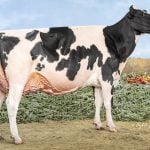In an ideal world, cattle traceability tag numbers could be effortlessly scanned as the animal walks down an alley, onto a truck, into a feedlot, and eventually into a packing plant with the information seamlessly uploaded to the Canadian Cattle Identification Agency’s CLTS database.
But cattle aren’t boxes in a Walmart store. Implementing RFID (Radio Frequency Identification) technology and identification is a challenge for livestock that live in everchanging weather conditions, bush and grassland pasture, barnyard and feedlot environments.
“The goal is to be able to have readers at various points where the animals traverse their life and as the animal walks by the reader, it can read the ear tag number and report it back to us automatically without affecting the producer,” said CCIA’s Tag and Technology Manager Paul Laronde.
That tag is one of the main pillars of traceability. Like a licence plate on a car, it uniquely identifies the animal in the system and its history. Lose a tag, and this information is disconnected from the animal.
While ear tags have been in use for decades, continuous improvements have enhanced both their performance and ease of use. The latest low-frequency electronic versions use wireless systems to capture and report the animal’s number autonomously.
Before an identifier such as an ear tag is approved in Canada, it must undergo stringent examination and testing. The International Committee on Animal Recording (ICAR) tests tags to ensure they meet performance criteria and conform to several ISO (International Organization of Standardization) standards.
Once a tag has successfully completed testing, it is registered with ICAR and certified.
In Canada, tags are also tested at extreme temperatures (+40 C to -35 C). In the past, some tags were so difficult to apply in cold weather that the tag, applicator, or both could break. CCIA has mandated temperature based standards to improve tagging ease and retention success rates.
Of course, tags are only useful if they stay on the animal. Tags that pass performance testing in the lab proceed to a field test, where they are applied to 1,200 to 1,500 animals on farms in Canada. The tags must remain on the animals for at least one year with a 98 per cent retention rate.
These tests also track any failures in application, an issue that is also at the forefront of CCIA’s new Retention Matters campaign. Laronde and others work with livestock producers to foster best practices for applying tags to ensure they stay put.
It usually takes 18 months to two years to test tags in Canada before they can be approved for sale. CCIA also tests randomly selected approved tags each year. All tests are completed in an ICAR-approved testing laboratory to ensure the highest standards and that tags in the Canadian market are among the best in the world.
CCIA also relies on the day-to-day knowledge of producers. Complaints trigger close inspection for manufacturing issues or errors, which are then resolved promptly with the manufacturers.
Ear tag technology continues to evolve. Veterinarian and former CCIA chair Dr. Pat Burrage says tags that use UHF might be an attractive option for some sectors of the industry. These tags allow multiple animals to be scanned at once and at a longer range than the current approved RFID tags.
“Technology is the limiting factor,” he said. “It can be done, but it can’t be done cost effectively.”
“If we have a program, it’s got to be cost effective. The low-frequency tag is by far the most superior when it comes to low cost and getting the job done,” said Burrage, who works as a consulting veterinarian with Telus Agriculture.
Livestock producers are supportive of a traceability system that tracks individual animals, identifies the premises and provides movement information. That said, they do want tags that can be read simply and stay in place for the life of the animal.
“We don’t run into situations where we see untagged cattle anymore,” Burrage said. “It is just routine now and just part of doing business. There is zero resistance out there.”
Producers also use RFID tags to record provenance, birth and health information. In feedlots, any medication or movement information can also be recorded.
“We’re trying to get to the point where we can report tag data automatically or autonomously, so people don’t need to write stuff down,” Laronde said. “It can just be scanned and sent to the database, and it makes producers’ lives easier. The technology is there, we’re just trying to figure out what bits do we need to make this work flawlessly.”
For further information on tag technology please visit www.retentionmatters.ca











